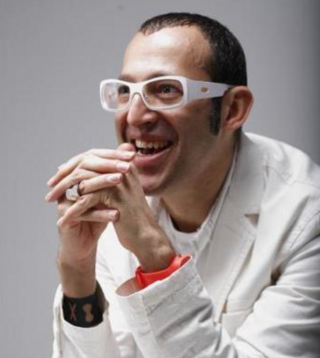Alessi is a housewares and kitchen utensil company in Italy, manufacturing and marketing everyday items authored by a wide range of designers, architects, and industrial designers — including Achille Castiglioni, Richard Sapper, Marco Zanuso, Alessandro Mendini, Ettore Sottsass, Wiel Arets, Zaha Hadid, Toyo Ito, Hani Rashid, Tom Kovac, Greg Lynn, MVRDV, Jean Nouvel, UN Studio, Michael Graves, and Philippe Starck. The Alessi company in the UK is worth around £2.4 million.

Michael Graves was an American architect, designer, and educator, and principal of Michael Graves and Associates and Michael Graves Design Group. He was a member of The New York Five and the Memphis Group and a professor of architecture at Princeton University for nearly forty years. Following his own partial paralysis in 2003, Graves became an internationally recognized advocate of health care design.

Karim Rashid is an Egyptian-born and Canadian raised industrial designer. His designs include luxury goods, furniture, lighting, surface design, brand identity and packaging. Time magazine has described him as the "most famous industrial designer in all the Americas" and the "Prince of Plastic". He is based in New York City, as well as Belgrade, Miami and India.
Donald Tobias Wong was a Canadian designer and artist. His work was heavily influenced by subversive art movements including Dada and Fluxus, and, having received numerous cease and desist orders, Wong become known for appropriating work by others. He used the term "paraconceptual" to describe his art.
Michael Gabellini, FAIA, is a minimalist architect, interior designer and partner of Gabellini Sheppard Associates with Design Partner, Kimberly Sheppard and Consulting Partner, Daniel Garbowit. A Fellow of the American Institute of Architects, he won the National Design Award for Interior Design in 2006 and has also been recognized with the Progressive Architecture Award and awards from the American Institute of Architects, the International Interior Design Association, among other professional societies and publications.
Giorgio Borruso is an Italian architect, known for his designs of international retail fashion houses. Since 2000, Borruso's firm has been based in Venice, Los Angeles, California.

Hani Rashid is an architect and educator. He co-founded the New York-based architecture firm, Asymptote Architecture with Lise Anne Couture.
Timorous Beasties is a design-led manufacturing company based in Glasgow that specialises in fabrics and wallpapers. The company was founded in 1990 by Alistair McAuley and Paul Simmons, who met while studying at the Glasgow School of Art. Winners of the Walpole Award for 'Best Emerging British Luxury Brand' in 2007 and 'British Luxury Design Talent' in 2010, the company now has three branded showrooms in Glasgow, London and Berlin and export worldwide.
Roman and Williams Building and Interiors is an American-owned, New York-based design studio known for its work on hotels, restaurants, retail spaces, homes and product design. Founded in 2002 by Robin Standefer and Stephen Alesch, the firm encompasses Roman and Williams Guild New York (RW Guild) - a brick-and-mortar store of premium, artful home furnishings, accessories and housewares which include Roman and Williams' own product design collection as well as specially crafted pieces produced by artisans from around the world. The RW Guild stand-alone is also home to Roman and Williams' French restaurant, La Mercerie, helmed by Chef Marie-Aude Rose and Emily Thompson Flowers.
Molo Design Limited, stylized as molo, is a multidisciplinary design and production studio based in Vancouver, British Columbia, Canada led by Stephanie Forsythe and Todd MacAllen. The studio integrates the practices of architecture, craft, and product design. molo products develop from Forsythe and MacAllen's materials research and studies.

TenBerke is a New York City, based architecture and interior design firm founded and led by Deborah Berke, who concurrently serves as Dean of the Yale School of Architecture.

Mel Smilow was an American furniture designer, artist, and partner in Smilow-Thielle, a mid-twentieth-century firm producing affordable, modern furniture and other interior furnishings, with retail outlets located in the greater metropolitan New York area and Washington, DC.
Hlynur Atlason is an Icelandic industrial designer based in New York City.
Slice Inc. was founded by T.J. Scimone in 2008 and is headquartered in Miami, Florida. The company mostly manufactures small hand-held cutting tools, including box-cutters, knives, and scissors.
Dakota Jackson is an American furniture designer known for his eponymous furniture brand, Dakota Jackson, Inc., his early avant-garde works involving moving parts or hidden compartments, and his collaborations with the Steinway & Sons piano company.
Grace Jeffers is an American writer, historian, educator and artist based in New York. She pioneered and continues to lead an interdisciplinary and integrated approach to the study of materials. Her writings and lectures draw on 20th century art, design and cultural history, emphasizing the intelligent use of synthetic and manmade materials in the practice of design.
The American Prize for Design was established in 2016 and is awarded annually by the Chicago Athenaeum Museum of Architecture and Design in collaboration with the European Centre for Architecture Art Design and Urban Studies within the context of the Good Design Awards. The prize is presented to a distinguished designer in the fields of industrial design, visual communication and graphic design in terms of excellence and further innovation along with the contribution of design in the quality of everyday life.
James von Klemperer is a New York-based American architect. He is president of the architectural firm Kohn Pedersen Fox (KPF). He is known for his contributions to the designs of new cities, urban mixed-use clusters, and supertall buildings, including the Lotte World Tower, currently the world's fifth tallest building, and One Vanderbilt, adjacent to Grand Central Terminal and currently the tallest office building in Midtown Manhattan.
Nienkämper is a furniture manufacturer founded by Klaus Nienkämper in 1968. The North American company operates a 120,000-square-foot factory in Toronto's east end that produces furniture for office, residential, institutional and hospitality applications with showrooms in Toronto, New York, Chicago and Dallas.
Janis Kravis was a Latvian architect who established Toronto's first concept store, Karelia, in 1959. A combination café, studio, and retail store, Karelia was a hub for Toronto's mid-century creatives that introduced Marimekko textiles and contemporary Finnish designs to central Canada.






